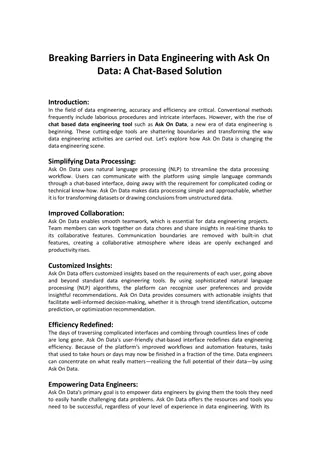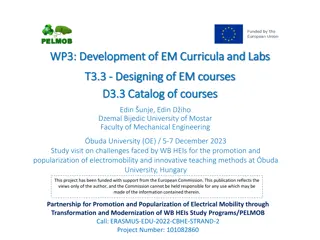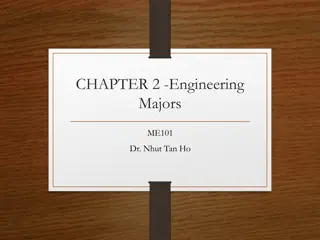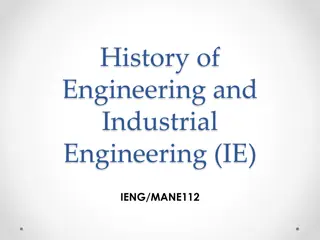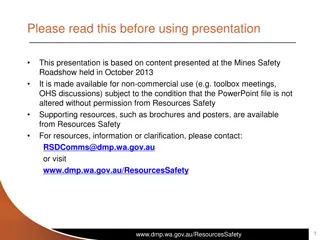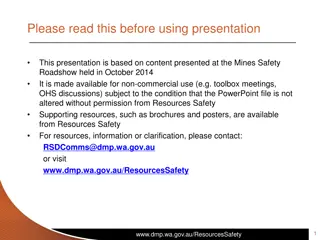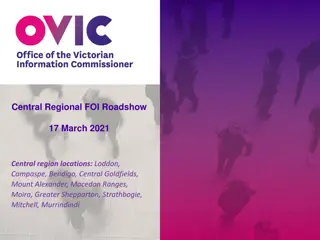
Cambridge Nationals in Engineering: Qualifications Overview
Discover the Cambridge Nationals in Engineering qualifications, recognized by the DfE as Technical Awards for KS4 performance tables. These qualifications offer a blend of academic and vocational curriculum, providing transferable skills and a pathway to further education and apprenticeships. Explore the key features, assessment models, and units available in the OCR Level 1/Level 2 Cambridge National in Engineering for Design, Manufacture, and Programmable Systems. Gain insight into the practical skills and experiences students can develop, enhancing their preparation for future studies and employment opportunities.
Download Presentation

Please find below an Image/Link to download the presentation.
The content on the website is provided AS IS for your information and personal use only. It may not be sold, licensed, or shared on other websites without obtaining consent from the author. If you encounter any issues during the download, it is possible that the publisher has removed the file from their server.
You are allowed to download the files provided on this website for personal or commercial use, subject to the condition that they are used lawfully. All files are the property of their respective owners.
The content on the website is provided AS IS for your information and personal use only. It may not be sold, licensed, or shared on other websites without obtaining consent from the author.
E N D
Presentation Transcript
Cambridge Nationals in Engineering Dean O'Donoghue OCR
Build brilliant Cambridge Nationals Developed with teachers, for teachers
KS4 Qualifications Landscape OCR redeveloped Cambridge Nationals are recognised by the DfE as Technical Awards for performance tables at KS4. They are equivalent to one GCSE for progress 8 in the open element. Up to three GCSE qualifications (including EBacc subjects not used to fill the slots in the EBacc element) and/or technical awards from the approved list. The target audience are those in secondary education who would benefit from a blended academic and vocational curriculum including MAT, UTCs, Independent, Free and Studio schools. OCR Cambridge Nationals provide a line of sight work and support progression to Level 3 and Apprenticeship provision. Technical subject areas such as Engineering support the Government Skills through progression to T Levels and transition programmes.
Transferable Skills These practical qualifications also give students the opportunity to gain broad, transferable skills and experiences that can be applied as they progress into their next stages of study and life. These may also enhance their preparation for future employment. Students will develop different transferable skills depending on the qualification(s) they take, but here are examples of some of the skills they may develop naturally as a result of completing the NEA assessments: Analytical Creative thinking Digital presentation Leadership Planning Problem solving Research Team working Verbal Communication/Presentation.
Cambridge Nationals in Engineering The key features for you and your students are: a simple and intuitive assessment model a specification developed with teachers specifically for teachers a flexible support package formed after listening to teachers needs three qualifications available
Cambridge Nationals in Engineering J822: OCR Level 1/Level 2 Cambridge National in Engineering Design (120 GLH) Unit 2 (30%) Unit 3 (30%) Unit 1 (40%) R040 Moderated (M) R039 Moderated (M) R038 Examined (M) J823: OCR Level 1/Level 2 Cambridge National in Engineering Manufacture (120 GLH) Unit 3 (30%) Unit 1 (40%) Unit 2 (30%) R016 Moderated (M) R014 Examined (M) R015 Moderated (M) J824: OCR Level 1/Level 2 Cambridge National in Engineering Programmable Systems (120 GLH) Unit 1 (40%) Unit 2 (30%) Unit 3 (30%) R047 Examined (M) R048 Moderated (M) R049 Moderated (M) M = Mandatory O = Optional GLH = Guided Learning Hours. The approximate time that the teacher will spend supervising or directing study time and assessment activities
Cambridge Nationals in Engineering These qualifications will help students to develop: valuable practical skills in engineering that are highly sought after in the workplace in Engineering Design, a deep understanding of the design process and the use of 2D and 3D design techniques to meet design specifications in Engineering Manufacture, a deep understanding of the processes, materials, tools and equipment used within the engineering, manufacturing, process and control sector in Engineering Programmable Systems, a deep understanding of the key principles that underpin how electronic and programmable technologies work.
Performance objectives (POs) Each Cambridge National qualification has related Performance Objectives. There are four Performance Objectives in each Cambridge National in Engineering Weightings for each Performance Objective can be found in section 4 of the specification.
Cambridge National in Engineering Design Our Cambridge National in Engineering Design will encourage students to: understand and apply the fundamental principles and concepts of Engineering Design, including the design process, types of drawings, influences on design, and the use of Computer Aided Design (CAD) develop learning and practical skills that can be applied to real-life contexts and work situations think creatively, innovatively, analytically, logically and critically develop independence and confidence in using skills that would be relevant to the engineering design and development sector and more widely analyse problems in design terms through practical experience of solving such problems, including designing, and modelling designs to meet a design brief understand the different stages of the iterative design process, recognising the cyclical nature of this approach evaluate designs through product disassembly and the process of using product analysis. The information in our session today is based on our draft specification submitted for consideration on key stage 4 performance tables in England for 2024. We expect the initial list of approved qualifications will be published in the autumn of this year.
Cambridge National in Engineering Design New Unit Assessment Content overview 48 GLH Examined 40% 70 Marks 1 hour 15 mins Design Strategies Communicating designs Techniques used to evaluate design ideas and outcomes, including modelling methods R038: Principles of engineering design Develop techniques in sketching Engineering drawing using standard conventions that include dimensioning, line types, abbreviations, and representation of mechanical features Using computer aided design (CAD), 2D and 3D software 36 GLH Moderated 30% 60 Marks 10 12 Hours R039: Communicating designs Learn how designers can quickly create and test models to develop a working prototype of a design Develop their virtual modelling skills using computer aided design (CAD) 3D software Develop their physical modelling skills using modelling materials or rapid-prototyping processes to produce a physical prototype 36 GLH Moderated 30% 60 Marks 10 12 Hours R040: Design evaluation and modelling
Engineering Design: examined unit R038: Principles of engineering design The question paper has two parts: Our approach is accessible to all: Section A Includes 10 multiple choice questions (MCQs) 48 GLH 1 hour 15 minute paper based written examination 70 marks (80 UMS) OCR-set and marked Start short and simple, then build Reading age taken into account Clear, concise questions SEND taken into account when writing the questions Section B Includes short answer questions and extended response questions. One extended response question will be assessed using a levels of response mark scheme. Sample question paper (draft) is available here
Engineering Design: NEA units R039: Communicating designs Our approach is extremely accessible: Tasks start at the beginning and then develop Sub bullets to help break down requirements Clear tips for each task Detailed mark schemes Approx 10 12 hours 60 marks (60 UMS) OCR set assignment Centre-assessed and OCR moderated The set assignment will contain 4 practical tasks. R040: Design evaluation and modelling Approx 10 12 hours 60 marks (60 UMS) OCR set assignment Centre-assessed and OCR moderated Section 4 of the specification includes the marking criteria and an overview of the tasks. The set assignment will contain 6 practical tasks.
NEA Tasks Unit R039: Communicating designs Section 4 of the specification includes the marking criteria and an overview of the tasks (example for R039 shown) Students must be able to produce freehand sketches of a design idea or design proposal using rendering techniques: thick/thin lines; texture; shading and annotation to demonstrate the design. Ensure that students produce a range of design ideas and proposals that respond to the specification provided, using both 2D and 3D techniques and utilise graphical communication methods to enhance their ideas. Task 1 Students are required to develop one design proposal further using rendering techniques to present both 2D and 3D sketches. Detailed annotation and labelling should be used to help describe the function, features, material choices, assembly methods etc. Students should explain how their design meets the design specification provided. The actual assignment will be released nearer to first teaching but while you do not have the context (brief) yet, the specification and marking criteria lists what they do in each task Task 2 Task 3 Students must be able to produce a 3rd angle orthographic drawing and an assembly drawing for a design proposal. They must You should ensure that students use CAD software to produce formal presentation design proposals. Students must demonstrate skill in using 2D and 3D CAD modelling Task 4
Cambridge National in Engineering Manufacture Our Cambridge National in Engineering Manufacture will encourage students to: understand and apply the fundamental principles and concepts of Engineering Manufacture, including manufacturing processes, engineering materials, manufacturing requirements and developments in engineering manufacture develop learning and practical skills that can be applied to real-life contexts and work situations think creatively, innovatively, analytically, logically and critically develop independence and confidence in using skills that would be relevant to the engineering, manufacturing, process and control sector and more widely plan manufacturing production through practical experience of manufacturing for one- off products and manufacturing in quantity determine the sequence of operations required, recognising hazards and risks so that control measures can be implemented for safe working interpret engineering drawings to facilitate manufacture, using a range of tools and equipment, including Computer Numerical Control (CNC) machines The information in our session today is based on our draft specification submitted for consideration on key stage 4 performance tables in England for 2024. We expect the initial list of approved qualifications will be published in the autumn of this year.
Cambridge National in Engineering Manufacture New unit Assessment Content overview 48 GLH Examined 40% 70 Marks 1 hour 15 mins Types of manufacturing processes, materials and the factors to be considered when determining the manufacturing requirements Properties of material Current developments in engineering manufacture R014: Principles of engineering manufacture Information required to make a product Plan the production of a product and carry out risk assessments for the processes Tools and equipment needed to produce a product in small quantities. Select and safely use the equipment, processes and tools Use a range of hand-held equipment and conventional (non-Computer Numerical Control (CNC) machining methods 36 GLH Moderated 30% 60 Marks 10 12 Hours R015: Manufacturing a one-off product Learn how to manufacture and use simple jigs and templates to support manufacturing in volume Use CAD software, learn about the information needed to facilitate manufacture and apply this in order to program Computer Numerical Control (CNC) equipment Set up and operate CNC equipment and how to monitor the quality of the manufactured products 36 GLH Moderated 30% 60 Marks 10 12 Hours R016: Manufacturing in quantity
Engineering Manufacture: examined unit R014: Principles of engineering manufacture Our approach is accessible to all: The question paper has two parts: Start short and simple, then build Reading age taken into account Clear, concise questions SEND taken into account when writing the questions Section A Includes 10 multiple choice questions (MCQs) 48 GLH 1 hour 15 minute paper based written examination 70 marks (80 UMS) OCR-set and marked Section B Includes short answer questions and extended response questions. One extended response question will be assessed using a levels of response mark scheme. Sample question paper (draft) is available here
Engineering Manufacture: NEA units R015: Manufacturing a one-off product Our approach is extremely accessible: Tasks start at the beginning and then develop Sub bullets to help break down requirements Clear tips for each task Detailed mark schemes Approx 10 12 hours 60 marks (60 UMS) OCR set assignment Centre-assessed and OCR moderated The set assignment will contain 5 practical tasks. R016: Manufacturing in quantity Approx 10 12 hours 60 marks (60 UMS) OCR set assignment Centre-assessed and OCR moderated Section 4 of the specification includes the marking criteria and an overview of the tasks. The set assignment will contain 5 practical tasks.
NEA Tasks Unit R015: Manufacturing a one-off product Section 4 of the specification includes the marking criteria and an overview of the tasks (example of a task overview for R015 shown) You should ensure that students have the opportunity to carry out relevant supporting research, which might be achieved by access to the internet. Please remind students about the requirement to reference all sources. Any appropriate format can be used for the production plan, so long as the information required to facilitate manufacture is presented. Students are not expected to produce working drawings of the part to be manufactured. Task 1 The assessment of risk can be either qualitative (e.g. high, low, medium) or quantitative. Students can use any appropriate formats for the risk assessment., but we do provide a template that students can use. Task 2 The actual assignment will be released nearer to first teaching but while you do not have the context (brief) yet, the specification and marking criteria lists what they do in each task Task 3 Students should be able to Task 4 No tolerances are specified as these will be dependent upon the resources available in individual centres. Students may wish to No tolerances are specified as these will be dependent upon the resources available in individual centres. Students may wish to .. Task 5
Cambridge National in Engineering Programmable Systems Our Cambridge National in Engineering Programmable Systems will encourage students to: understand and apply the fundamental principles and concepts of Engineering Programmable Systems, including the principles of electronic circuits, the components and device used in electronic and programmable systems, and how to construct and test them develop learning and practical skills that can be applied to real-life contexts and work situations think creatively, innovatively, analytically, logically and critically develop independence and confidence in using skills that would be relevant to the maintenance, installation and repair sector and more widely use computer aided design (CAD) software to produce diagrams and simulate circuits construct and test electronic circuits for a specific purpose, using tools and equipment to assemble printed circuit boards solve problems using microcontroller programs to develop programmable systems and test that they solve such problems. The information in our session today is based on our draft specification submitted for consideration on key stage 4 performance tables in England for 2024. We expect the initial list of approved qualifications will be published in the autumn of this year.
Cambridge National in Engineering Programmable Systems New unit Assessment Content overview 48 GLH Examined 40% 70 Marks 1 hour 15 mins R047: Principles of electronic and programmable systems Key principles that underpin how electronic and programmable technologies work Ways systems are represented, tested and assembled commercially Develop knowledge and understanding of electronic circuit components 36 GLH Moderated 30% 60 Marks 10 12 Hours Skills required to construct and test electronic circuits How to simulate circuits using CAD software and physically inspect and test them once assembled How to produce printed circuit boards (PCBs) How to identify common faults in circuits that do not work as expected R048: Making and testing electronic circuits 36 GLH Moderated 30% 60 Marks 10 12 Hours How to draw block diagrams of systems How to determine hardware and system requirements to meet a given brief, including the selection of appropriate input and output devices Use software to program microcontrollers and test systems to make sure that they work correctly R049: Developing programmable systems
Engineering Programmable Systems: examined unit R047: Principles of electronic and programmable systems The question paper has two parts: Our approach is accessible to all: Section A Includes 10 multiple choice questions (MCQs) 48 GLH 1 hour 15 minute paper based written examination 70 marks (80 UMS) OCR-set and marked Start short and simple, then build Reading age taken into account Clear, concise questions SEND taken into account when writing the questions Section B Includes short answer questions and extended response questions. One extended response question will be assessed using a levels of response mark scheme. Sample question paper (draft) is available here
Engineering Programmable Systems: NEA units R048: Making and testing electronic circuits Our approach is extremely accessible: Tasks start at the beginning and then develop Sub bullets to help break down requirements Clear tips for each task Detailed mark schemes Approx 10 12 hours 60 marks (60 UMS) OCR set assignment Centre-assessed and OCR moderated This set assignment contains 3 practical tasks. R049: Developing programmable systems Approx 10 12 hours 60 marks (60 UMS) OCR set assignment Centre-assessed and OCR moderated Section 4 of the specification includes the marking criteria and an overview of the tasks. This set assignment contains 3 practical tasks.
NEA Tasks R048: Making and testing electronic circuits Section 4 of the specification includes the marking criteria and an overview of the tasks (example of a task overview for R048 shown) You should ensure that students have access to CAD software that is capable of circuit schematic entry, simulation and which can also produce PCB layouts. Component libraries within the software will need to have components required for the circuit in the scenario. As these are common components these should be available in most CAD software. Students will need to show clearly, step by step, how they have used CAD software to schematically enter the circuit, perform simulation and create a PCB layout. This can be done with a series of annotated screen shots which must be individual to each student. Simulation will require component values to be modified with the effects of this being investigated as part of the simulation. Students will need to show both track and component side views of the PCB layout. Task 1 The actual assignment will be released nearer to first teaching but while you do not have the context (brief) yet, the specification and marking criteria lists what they do in each task Task 2 You should ensure that students . Task 3 You should ensure that students .
Results and grading Results and grading are very similar to our current qualifications with the exception of the new terminal requirement for the exam the exam taken in the final series will always count towards the qualification Pass The best of any multiple attempts of the NEA units are used towards the overall qualification The result of the exam taken in the final series (when certificating) is used towards the overall qualification Every Mark Counts all marks gained contribute to the full qualification even if the unit result was a u (unclassified) The uniform marks (UMS) from the three units are simply added together to give a final mark out of 200 Level 1 Merit Distinction Pass Merit Level 2 Distinction Distinction* Qualification grade Max Uniform Mark Distinction* at Level 2 Distinction at Level 2 Merit at Level 2 Pass at Level 2 Distinction at Level 1 Merit at Level 1 Pass at Level 1 Unclassified (U) 180 160 140 120 100 80 60 0 200
Timeline of availability Redeveloped specifications are for first teaching September 2022 Current specifications June 2023 Last full series Moderation, examination and certification available January 2024 Resit opportunity for the examination, no moderation series. Last certification opportunity Redeveloped specifications January 2023 First moderation series for redeveloped specifications June 2023 Moderation available for the redeveloped specifications January 2024 First examination series for redeveloped specifications First certification for the redeveloped specifications
Support and resources Late Autumn 2021 to spring 2022 March to September 2021 First Teaching professional development: from autumn 2021 March 2021 Understanding the Assessment guidance: examined and moderated Mapping guides Switching guides FAQs listed on support hub Schemes of work Published for all units in early 2022 Detailed documents including suggested lesson content and activity ideas April/May/June 2021 Cambridge Nationals Explained brochure Introducing Cambridge Nationals e-learning resource Choosing OCR professional development webinars Annotated Sample Assessment Materials (SAMs) Publisher Support Assessment support Internal assessment guides and FAQs Candidate-style exemplification: exam units Textbooks, revision guides, teaching resource packs, from leading publishers, including: Summer 22 onwards Updated internal assessment e-learning modules (train.ocr.org.uk) Full programme of professional development (including NEA marking workshops) Q&As with OCR examiners/moderators Set of mock papers (summer 2023) Options evening packs September 2021 Posters Subject-specific handouts Subject-specific presentation Subject specific videos Publishing from March 2022
Thank you for joining today s session, we hope you found it useful! support@ocr.org.uk


